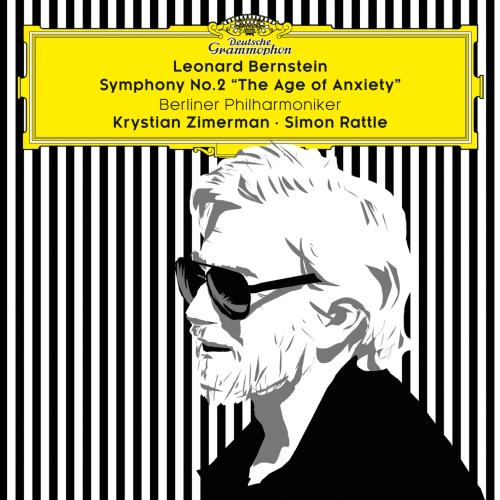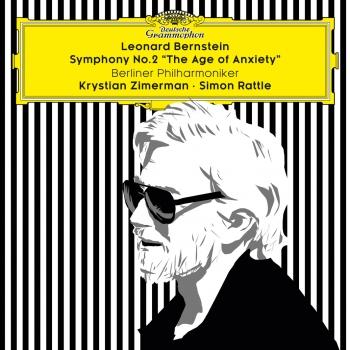
Bernstein: Symphony No. 2 "The Age of Anxiety" Krystian Zimerman
Album info
Album-Release:
2018
HRA-Release:
24.08.2018
Label: Deutsche Grammophon
Genre: Classical
Subgenre: Orchestral
Artist: Krystian Zimerman
Composer: Leonard Bernstein (1918-1990)
Album including Album cover Booklet (PDF)
I`m sorry!
Dear HIGHRESAUDIO Visitor,
due to territorial constraints and also different releases dates in each country you currently can`t purchase this album. We are updating our release dates twice a week. So, please feel free to check from time-to-time, if the album is available for your country.
We suggest, that you bookmark the album and use our Short List function.
Thank you for your understanding and patience.
Yours sincerely, HIGHRESAUDIO
- Leonard Bernstein (1918-1990):
- 1 Leonard Bernstein on “The Age of Anxiety“ - Interview by Humphrey Burton 01:48
- Symphony No. 2 "The Age of Anxiety" / Part 1 / 1. The Prologue:
- 2 Lento moderato 02:25
- Symphony No. 2 "The Age of Anxiety" / Part 1 / 2. The Seven Ages:
- 3 Variation 1. L'istesso tempo 01:00
- 4 Variation 2. Poco più mosso 01:29
- 5 Variation 3. Largamente, ma mosso 01:26
- 6 Variation 4. Più mosso 00:51
- 7 Variation 5. Agitato 00:51
- 8 Variation 6. Poco meno mosso 01:30
- 9 Variation 7. L'istesso tempo 02:00
- Symphony No. 2 "The Age of Anxiety" / Part 1 / 3. The Seven Stages:
- 10 Variation 8. Molto moderato, ma movendo 01:49
- 11 Variation 9. Più mosso. Tempo di Valse 01:20
- 12 Variation 10. Più mosso 00:31
- 13 Variation 11. L'istesso tempo 00:54
- 14 Variation 12. Poco più vivace 00:13
- 15 Variation 13: L'istesso tempo 00:42
- 16 Variation 14: Poco più vivace 00:34
- Symphony No. 2 "The Age of Anxiety" / Part 2 / 1. The Dirge:
- 17 Largo 07:35
- Symphony No. 2 "The Age of Anxiety" / Part 2 / 2. The Masque:
- 18 Extremely fast 04:30
- Symphony No. 2 "The Age of Anxiety" / Part 2 / 3. The Epilogue:
- 19 L'istesso tempo - Adagio / Andante - quasi cadenza - Lento molto 08:20
Info for Bernstein: Symphony No. 2 "The Age of Anxiety"
“Zimerman’s pianism was extraordinary, a staggering combination of dexterity with nuance, each phrase telling a story. Rattle breathed with him, the two sharing razor-sharp wit and a mood of playful delirium with the orchestra,” Financial Times, 20 June 2018.
Shooting from the hip was Leonard Bernstein’s style. If an idea sprang to mind or a strong feeling came over him, the mercurial American composer-conductor would set it free. When he was seventy, he threw himself headlong into performances of his Symphony No.2 The Age of Anxiety with Krystian Zimerman. “Will you play this piece with me when I’m 100?”, asked Bernstein backstage. The pianist agreed. He must have been tempted to book the date immediately, such was the older man’s incredible life force. Yet that force gave out two years later when Bernstein, struggling with multiple lung infections, died from a heart attack. Zimerman remembered Bernstein’s invitation and chose to perform The Age of Anxiety to mark its composer’s centenary year. He was joined in June by the Berliner Philharmoniker and Sir Simon Rattle, the latter giving one of his last concerts as the orchestra’s chief conductor. The results, recorded live by Deutsche Grammophon, are set for release to coincide with Bernstein’s hundredth-birthday commemorations on 25 August 2018. Zimerman teams up with Rattle and the London Symphony Orchestra in August and September to give further performances of the symphony at the Edinburgh , Salzburg and Lucerne festivals, and at Tokyo’s Suntory Hall.
Leonard Bernstein, himself a fine pianist, met Krystian Zimerman soon after the young Polish musician’s victory at the 1975 International Chopin Piano Competition in Warsaw. Their first recording together for the yellow label, Stravinsky’s Les Noces, appeared in 1977 and was followed by cycles of the Brahms and Beethoven piano concertos. “I’ve never conducted better in my life,” Bernstein noted when they recorded Beethoven’s last three piano concertos with the Vienna Philharmonic Orchestra in September 1989 (he didn’t live long enough to record the first two, which Zimerman ultimately directed himself, from the keyboard). Three years earlier they had performed The Age of Anxiety with the London Symphony Orchestra after Zimerman had mentioned in passing that he’d already played the piece. “When I said I’d performed the Second Symphony before, he almost fainted,” the pianist recalls. “He said, ‘How come I didn’t know?’ and I replied, ‘You never asked!’ He said: ‘We have to play it…’” The conductor’s trademark spontaneity made an enduring impression on Krystian Zimerman. “He gave me the courage and confidence to be daring with my interpretations, trying out musical ideas that were completely new,” he observes.
Courage and confidence lie behind Bernstein’s Second Symphony. In 1949, around the time of the work’s premiere, its young composer attended the Cultural and Scientific Conference for World Peace, held at New York’s Waldorf-Astoria Hotel. He heard speeches given by senior colleagues, Aaron Copland and Dmitri Shostakovich among them, which exposed the growing divide between western democracies and Joseph Stalin’s Soviet Union. No artist, observed Copland, can function in the “mood of suspicion, ill-will, and dread that typifies the cold war attitude”. The House Committee on Un-American Activities was already at work weeding out communists and communist sympathisers from the movie industry, while Senator Joseph McCarthy’s anti-communist witch hunt had begun to persecute many artists, writers, composers and others considered to be “subversives”.
Bernstein found a clear reflection of cold war realities in W.H. Auden’s Pulitzer Prize-winning poem The Age of Anxiety. Here was a bleak portrait of post-war youth in the form of a dialogue between four characters who meet in a New York bar. Their search for meaning, pursued over drinks and during an alcohol-fuelled “dream-odyssey”, chimed with Bernstein’s personal interest in psychology; the poem’s title, meanwhile, expressed his alarm at the rise of political intolerance and cynicism. Auden’s work provided the composer with his symphony’s two-part structure and its six episodes. It also influenced his diverse musical reflections on a time when free speech was yielding to fear and deception, established truths to conspiracies and lies. Bernstein considered The Age of Anxiety to be his “most American work”, a telling verdict given the music’s antiheroic, often tragic nature. “At least one of the characters does find the core of faith, which is what one is after and what I’m after, I guess, in every work I ever write,” he told his biographer Humphrey Burton in an interview clip that prefaces the symphony’s new Deutsche Grammophon recording.
Krystian Zimerman and Sir Simon Rattle revelled in the work’s theatrical nature, spotlighting an essential quality sanctioned by the composer himself. “If the charge of theatricality in a symphonic work is a valid one, I am willing to plead guilty,” Bernstein wrote in the programme note for the symphony’s first performance in 1949. The composer’s longer-term view of the piece was affected by the harsh criticism that followed its premiere and by his evolving search for a distinctive American symphonic language. “He told me personally that the first time he played it himself, with [Serge] Koussevitzky, Koussevitzky didn’t like parts of it and asked him to rewrite it,” notes Zimerman. “That’s where we differed. I always liked the piece and believed in it. Bernstein knew that this is exactly the advantage that an interpreter or actor has: the ability to give a piece a life that the composer is sometimes too ashamed, too modest or too uncomfortable to present in the work himself.”
Zimerman’s passion for The Age of Anxiety intensified across his three performances with the Berliner Philharmoniker earlier this summer. Strong flavours of Stravinsky emerge in his performance of the composition’s “Seven Ages” variations to share the stage with the wild jazz-inflected, white-knuckle ride of “The Masque” and great expressive contrasts of “The Epilogue”. Their striking combination reinforced the pianist’s conviction that Bernstein’s Second Symphony is a work of genius. “I realised two years ahead of Lenny’s centenary that he was about to be one hundred. So I looked into the music again – and it’s great. It’s so much fun. And it’s so much like him – with all the freshness and flexibility and craziness of his character.”
Krystian Zimerman, piano
Die Berliner Philharmoniker
Sir Simon Rattle, conductor
Krystian Zimerman
Krystian Zimerman rose to fame at an early age when he was the youngest pianist to be awarded First Prize in the Chopin Competition at the age of 18. He has since embarked on a world-class career working with the world’s most prestigious orchestras and giving recitals in the top international concert halls.
Born into a family with a music-making tradition, musicians would meet almost daily in Zimerman’s home to play chamber music, and these performances afforded him an intimate, natural, everyday contact with live music. He undertook his first steps in music under his father’s supervision and then, at the age of seven, started working systematically with Andrzej Jasinski, then a senior lecturer at the conservatoire in Katowice.
He has collaborated with many pre-eminent musicians: chamber partners such as Gidon Kremer, Kyung-Wha Chung and Yehudi Menuhin, and conductors such as Leonard Bernstein, Herbert von Karajan, Seiji Ozawa, Riccardo Muti, Lorin Maazel, André Previn, Pierre Boulez, Zubin Mehta, Bernard Haitink, Stanisław Skrowaczewski and Sir Simon Rattle. In 2010 Zimerman performed the Chopin Birthday recital on the anniversary of the composer’s birth in the International Piano Series in London as part of the Chopin 200 celebrations. Since 2013 marks the 100th anniversary of the birth of Lutoslawski, Zimerman will be performing the Piano Concerto, which the composer wrote for him, in a number of cities worldwide including at the Royal Festival Hall, London with the Philharmonia Orchestra and Esa-Pekka Salonen.
Since making the decision to transport his own piano for every performance, he has alerted audiences to the complexities and capabilities of the instrument. The confidence which is afforded by always performing on his own, thoroughly-familiar instrument, combined with his own piano- building expertise (acquired in Katowice and developed through close co-operation with Steinway’s in Hamburg) allows him to reduce to an absolute minimum anything which might distract him from purely musical issues.
Zimerman lives with his wife and family in Switzerland where he has spent the greater part of his life, dividing his time between family, concert life, chamber music and, over the last few years, a teaching position at the Music Academy in Basel. He limits himself to 50 concerts per season and pursues a comprehensive approach to the musical profession, organising his own management, studying hall acoustics, the latest sound technology and instrument construction. He has also applied himself to the study of psychology and computer science.
He has developed a similar approach to recording, a process which he controls at each and every stage. During his long collaboration with Deutsche Grammophon his recordings have earned him many of the most prestigious awards. In 1999 he recorded the Chopin Concertos with an orchestra specially formed for this project, the Polish Festival Orchestra, with whom he then toured throughout Europe and America, performing these two works to commemorate the 150th anniversary of Chopin’s death. His most recent recording is a disc of chamber music to celebrate the 100th anniversary of Polish composer Grazyna Bacewicz whose music he has championed. (Source: Harrison Parrott)
Booklet for Bernstein: Symphony No. 2 "The Age of Anxiety"










